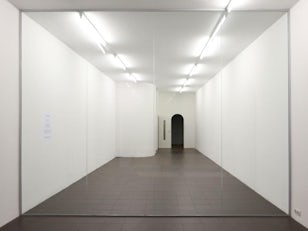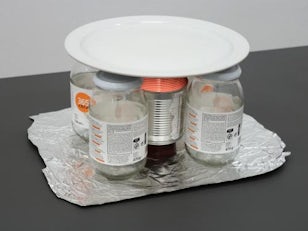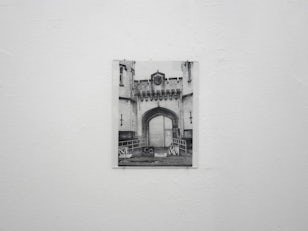
But outside what? Because when you leave here you become aphasic? When you leave here you continue to speak, consequently you continue to be inside.
Jacques Lacan, 3 December 196901
For the English-language title of Jacques Lacan’s 1969–70 seminar, L’envers de la psychanalyse, translator Russell Grigg chose The other side of psychoanalysis. Keen to emphasise in his note that the French word envers connotes ‘the unseen, even the obscene’, which the English ‘other side’ barely touches upon, Grigg echoes Lacan’s claim that discourse makes visible only the measurable part of intersubjectivity.02Then, what is seen? What is the scene? Établissement d’en face is a state-funded art space run by artists and curators since 1991. It has played a key role in articulating an international contemporary art scene in Brussels for nearly thirty years. Belgian artist Sara Deraedt’s first solo exhibition in the city she lives in – and the first by a woman in three years of Établissement’s programming – was closed to the public for over two months due to government regulations. 03 The hole in the middle of the exhibition’s duration is made by closed doors and silence, while the artworks stand through the hiatus. In a way, the shuttering is commensurate with the brutality the exhibition represents. The backside of the opening is the closing; the flipside of sociability is hostility; the other side of freedom is the fishbowl. (These are relations, not dichotomies.) In her only published interview, Deraedt gives words to my sense that her art resists mastery: ‘The reason for my silence in the company of my work—for example to not have printed texts within my exhibitions—is not to be mysterious or to leave the audience with a need for knowledge, or to create something opaque. It is exactly the opposite.’ 04
A student in Lacan’s seminar at Vincennes says the movement must go outside to find the means of overthrowing the university: the discourse of Lacan will never provide the tools of critiquing the ideology professors make students swallow. In spite of such manifest disapproval and a desire to get out, the student attends the seminar in the hope of recruiting others to leave. The student wants to retort Lacan, to cut through his seminar and reveal the hypocrisy of its contents. Still, the student’s claim represents scarcely more than a desire for Lacan’s perceived mastery, a desire for the master to become real, thus validating the student’s claim to look (for another) outside. In endowing the professor with this power, the student makes him into a symbol of the university, and reifies the latter. The student demands that the university affirm there is indeed an outside, which demonstrates mainly that the student is beholden to that discourse. The student receives no satisfaction from Lacan: ‘What you aspire to as revolutionaries is a master. You will get one.’ 05
According to Lacan, the so-called University discourse functions to make knowledge into a value by providing credit points (unités de valeur) in line with the Master’s discourse – capitalism, patriarchy, etc., but let’s say the place of the Master is more or less empty – and making anyone speaking from that space by definition an adherent. 06 What is not known, what is resistant to being qualified, is suppressed in the name of the maintenance of this kind of quantified knowledge. 07 A couple of minutes after the student’s confrontation, the seminar ends abruptly with Lacan stating that the liberal regime can see the rebellious students enjoying themselves and is happy to put this enjoyment on display.
What cannot be claimed by the liberal regime is precisely the part of knowledge that is not qualified, not recognisable, that cannot be known or accounted for. The students’ desire that their professor recognise an outside, where the students imagine allying ‘with the laborers, with the peasants and with the workers’, confirms Lacan’s observation that they are inevitably incapable of sparking revolution. 08 The claim for mastery is nowhere subverted, merely relocated – and this is commensurate with the liberal regime’s willingness to put the student protests on display. The critique the student is anxious to find beyond the university can only be incorporated for it poses no threat to the liberal regime (at the time of Lacan’s seminar, this regime was incarnated by Georges Pompidou). 09 The student believes they already know who is on the outside (a list of categories: labourers, peasants, workers), and ultimately seeks credit for this intervention into the seminar. But only something structurally unrecognisable could subvert the university discourse and the regime: resistance without mastery, subjectivity without guarantee, no satisfaction.
Like the students in Lacan’s seminar who seek an outside from which to critique their university, professional artists are compelled to use the institutionalised reflex of critique to account for their artworks, like their speech operates outside the system that endorses it. Nowadays the desire for a professor-master or a peasant-master has resolved into the desire for self-mastery, but the critical imperative remains. And so artists generate critique, which means imagining a self outside of one’s actions: imagining that meaning can be assured in advance, and mentally eliminating the reality of the public bringing unknown significance to the work. The claim for mastery in the form of critique is not subverted, only relocated (those who don’t make claim often do not appear). The content may vary, the form remains: critique is the form of the maintenance of the status quo. The art market (like the Pompidou government) is gratified to put such critique on display, for critique is the common denominator, generating value regardless of content, keeping units of value in circulation. Resistance to this imperative occurs by way of something personal and unknown that touches on something transparent and non-proprietary between subjects.

What specifically Deraedt isn’t claiming is less relevant than the mechanisms that actualise the part of knowledge shared between the artist and the audience, which is not governed. This is the part that has no guarantee, no insurance and is therefore the precise opposite of opaque. The mechanisms Deraedt uses are gestures to block, deflect and humiliate (in the sense of make humble, bring low) the critical reflex. The entrance passage into Établissement d’en face’s main gallery on street-level is physically blocked with a wall of glass, Wall (2020). Attendants to the opening are crammed in the entrance, unable to pass directly into the large street-level gallery in which artworks usually hang. What you see is yourself and others like you. The other side of this glass (the inside, also containing the kitchen and toilet) is accessed via an excessive descent-traverse-ascent by way of the basement gallery. Once reached, what you get on the other side is more exposure, the inside of a foolish fishbowl. In displaying the scene, Deraedt blocks the smooth passage of what is seen by the scene and replaces it with the flipside: an obstruction. (This is how woman interacts with the world.) Visitors and hosts physically undertake the transformation of the scene’s usual passage, enclosing themselves in the opening. 10

Stove (2020) is a makeshift stove atop a collapsible black table. A white dinner plate is balanced on four 470g jars of the cheapest mayonnaise from the cheapest home-brand of a big Belgian supermarket chain, stood upon a square of aluminium foil. The jars are grouped closely around a label-less tin containing a candle; the light moves. I wish this candle heated the plate; the stove emits a little heat. Such is the centrepiece of the basement gallery, which has often served as a late night art bar, around which one may seek the warmth of a scene. As a consequence, there is something humiliating about the sight of the stove. The source of warmth and food can be thought of as providing a place to gather, a table is a place for conversation, but Stove demands silence. The scene carries its free wine and beer along for the visit; stomaching the poverty and humility of this device is not a given. This is not so much about poverty of materials as it is about what humiliation does to subjects: humiliation makes invisible, humiliation is what is not seen. Or: when it is seen, it can only be hostile. (This is the structure of class.)
Three small lead pencil drawings of different cropped façades of the local prison (the inside of which most visitors can only imagine) hang in the basement galleries, and one hangs in the streetside office. They are detailed and photo-realist, grey-scale; it looks to be A4 printer paper. Knowing Brussels, I recognise the façade, but cannot say what it is or why I know it. (This is how the unconscious operates.) In this sense, though the drawings appear intimate, emit a strange light and draw me closer, they push me back into myself. For, in the absence of actual knowledge (of the prison), it is the seen and the scene that take shape in my mind, filling what can only be a fantastical gap. Like this, Établissement and the opening come to be negatively defined; they provide legibility for the moment when recognition lapses, propping up the critical reflexes on which the credibility of contemporary art depends. This is why, looking at Deraedt’s drawings of the façades, whose title is simply the prison’s street address – Avenue E. Ducpetiaux 106 – Saint Gilles (2019) – I in no way imagine the artist’s personal experience with prisons, but am rather left with my own subjectivity, and the social. In this act of deflection it is tangible that the other side of knowledge is projection, that the underside of imagination is the subject.

Deraedt’s exhibition shows that what is not seen (‘unseen’) and a certain limit of the scene (‘obscene’) outline the possibility of resistance to the master’s critical discourse. At her opening I perceived a staging of the dynamics of the scene at Établissement where a new orientation in this space is possible for the public. Whether this endures is beside the point. But I wanted to work out how these gestures of resistance could be distinguished from gestures of refusal. This question came up because the latter is a descriptor John Kelsey uses in reference to Merlin Carpenter’s artwork The Opening (2007–09). With the gesture of rapidly painting pre-hung stretched and primed canvasses during the vernissages of this series of solo shows, in Kelsey’s formulation, Carpenter refuses ‘to hand over any more living labor than is logically necessary in the creation of aesthetic surplus value’. 11Though installers, gallerists, critics and audiences likewise contribute living labour toward the generation of aesthetic surplus value for this artwork, they are conversely in no position to refuse these roles.12 I agree with Kelsey that the subject should put itself at risk inside the accumulation processes that extract life from us, and that this risk should be shared. 13 Yet when nothing eludes the artist’s discourse and everyone is recruited, there is no risk: in such artworks, whatever the scene, the audience-as-decoration marks the desire for the last word and ultimately for the control of meaning. Whatever is signified rests conclusively in the hands of the master (now an artist). No longer is it students asking for permission to go outside but artists inadvertently taking themselves for the outside of the event because they have predetermined what it will mean for everyone present. 14
Resistance on the other hand works the real into the equation by showing something that the institution does not ultimately control, and this is discomforting to consume. The un- (in ‘unseen’) designates what is not, an absence, and the ob- (in ‘obscene’) designates what is hostile or goes against. If we follow Lacan’s seminar about the ‘other side’, there is no seen and no scene without a ‘back’ side (‘bad side’, another of Grigg’s suggestions). Deraedt’s work is not sociable; it is not accessible; it shows the audience’s lack of freedom, and in turn that of the artist herself. But because we are left alone, not told what to think, connection feels possible. She shows somehow – paradoxically – what is cut off from us in that moment of looking, without allowing the audience (players whose thoughts remain radically unknown) to disconnect from their subjectivity. All of which is breathtaking because the cut connects to the real. And because it can just as easily be seen as ‘nothing’ – resistance without mastery, subjectivity without guarantee, no satisfaction.
Footnotes
-
Jacques Lacan, The Seminar of Jacques Lacan . Book XVII. The Other Side of Psychoanalysis, (ed. Jacques-Alain Miller, trans. Russell Grigg), New York: Norton 2007, p. 205.
-
‘Translator’s Note’, in J. Lacan, op. cit., p. 9.
-
‘Sarah Deraedt’, Établissement d’en face, Brussels, 8 February–7 June 2020.
-
Jamie Stevens, ‘Sara Deraedt: In Public’, Mousse 60, October–November 2017, p. 298.
-
J. Lacan, , op. cit., p. 207.
-
Thank you to artist and psychoanalyst Elizabeth Newman for her advice about Lacan and this seminar in particular. See: Elizabeth Newman, Texts, Melbourne: Discipline 2019.
-
Samo Tomšič provides a succinct description of what happened following university reform: ‘This quantification and commodification of knowledge turned the university into a factory, whose goal is to produce subjects of value, which join the established regime of knowledge … Of course, Lacan’s point is more general and addresses the historical production of capitalist subjectivity, which is possible through the quantification of labour and the isolation of labour-power in living bodies with the help of disciplines like energetics and thermodynamics. From this perspective, the historical intertwining of commodification of labour with natural sciences ended up producing a calculable and measurable subjectivity.’ Samo Tomšič, ‘Psychoanalysis, Capitalism, and Critique of Political Economy: Toward a Marxist Lacan’, in Samo Tomšič & Andreja Zevnik (ed.), Jacques Lacan: Between Psychoanalysis and Politics, New York: Routledge 2016, p. 158.
-
J. Lacan, op. cit., p. 205.
-
See: Luc Boltanski and Eve Chiapello, The New Spirit of Capitalism (trans. Gregory Elliott), London: Verso 2007.
-
This mechanism made me think of Catherine Malabou’s philosophy of the feminine, which opens a path for thinking woman as ‘an essence that is resistant because empty’. Catherine Malabou, Changing Difference: The Feminine and the Question of Philosophy, trans. Carolyn Shread, Cambridge, UK/Malden, MA: Polity Press 2011, p. v.
-
John Kelsey, ‘The Self-Employment Rate’, Rich Texts: Selected Writing for Art, Berlin: Sternberg Press 2010, p. 188.
-
Merlin Carpenter addresses surplus value and social relations in a more recent book, writing ‘that there is a potential to extract value from social relations’, and later ‘art … does not produce surplus value, but is a reward gained from the wages of the manager and is an extraction from surplus value produced elsewhere.’ Merlin Carpenter, “The Outside Can’t Go Outside”, Berlin: Sternberg Press 2018, pp. 14–18.
-
J. Kelsey, op. ci t., p. 187.
-
J. Kelsey, op. ci t., p. 187.
